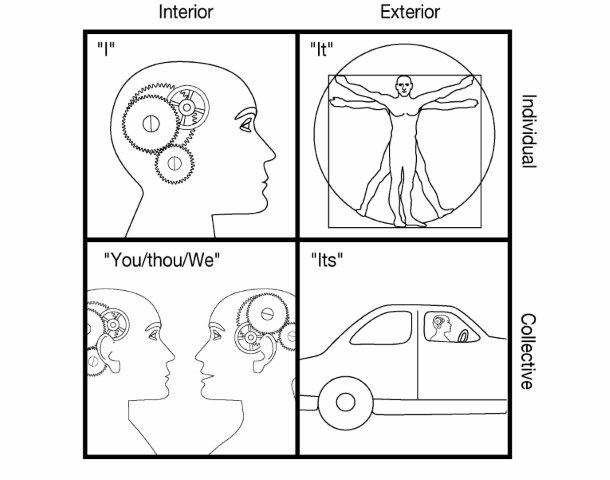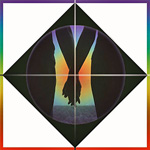Individual holons (humans) have four distinct dimensions that are intrinsic to the holon’s existence:[i]
- An individual interior subjective/experiential “I” or mind.
- An individual exterior objective/material “it” or form/body.
- A collective interior intersubjective “we” or shared values/culture.
- A collective exterior inter-objective “its” social environment.[ii]
For easy reference, the AQAL model diagrams these four dimensions as four quadrants that are labeled:
- Upper Left (UL) “I”
- Upper Right (UR) “It”
- Lower Left (LL) “We”
- Lower Right (LR) “Its”
| UL “I” Subjective Individual Interior |
UR “it” Objective Individual Exterior |
| LL “we” Cultural Collective Interior |
LR “its” Social Collective Exterior |
The four quadrants of individual holons
In other words, the four quadrants represent your individual consciousness in the upper left, and physical body in the upper right-hand quadrant, and how these two dimensions are extended and connected to the world around you in the lower quadrants.

You–being an individual holon–can experience these four dimensions right now:[iii]
(1) The Upper Left (UL) quadrant represents your subjective individual interior “I“ dimension. You experience this dimension when you focus your attention inward and ask yourself, “what is alive in me right now?” It includes the full spectrum of your awareness, from sensations, to feelings, thoughts, dreams, intentions, intuitions, perceptions, and sense of beauty. The levels of consciousness development, spiritual state-stages, and personality types that we explored in Part I are located in this quadrant. Introspection, psychotherapy, cognitive development, and meditation are UL practices.
(2) The Upper Right (UR) quadrant represents your objective individual exterior, physical “it” dimension that can be observed by you or anyone else. It includes your sex, skin, muscles, cells, hormones, enzymes, brain structures, smell, voice, height, size, etc. Differences in male and female bodies, such as their gender characteristics (breasts, penis, vagina, body hair, etc.), hormonal levels (testosterone, estrogen, etc.), and genetic makeup (X and Y chromosomes, etc.), are located in the Upper Right. Behaviors such as physical exercise, body language, and emotional outbursts fall into the UR quadrant.
(3) The Lower Left (LL) quadrant represents your collective interior (cultural) “we“ dimension. You experience this dimension when you focus your attention outward and ask yourself, “how do I relate to others and how do they affect my awareness?” This includes everything that you have learned through your culture, such as language, religious beliefs, worldviews, moral values, commitments, humility, empathy, compassion, devotion, and faith. Your way of creating mutual understanding with others, intimacy (which we can rewrite as “into-me-you-see,” emphasizing the interpersonal nature of intimacy),[iv] and vulnerability, as well as the lines of moral, communicative, worldview, value, and anima/animus complex development, are located in this quadrant. Communication and management training, couples therapy, conflict resolution, mediation, petitionary prayer, and religious beliefs fall into the LL quadrant.[v]
(4) The Lower Right (LR) quadrant represents your collective exterior (social) “its“ dimension. You experience this dimension when you focus your attention on the physical world around you and ask yourself, “what is the social, economic, and ecological environment that sustains my body?” This includes the air that you breathe, the food that you eat, shelter, possessions, occupation, financial assets/liabilities, social status, physical relationships, family, friends, and community. How a woman evaluates you as a protector/provider, and how you are seen by others with her on your arm are located in this quadrant. Family relations, social activities, educational systems, community building, team sports, money management, relationship laws (such as legal marriage and divorce), and acceptable conduct between men and women (such as sexual harassment, who buys the diamond ring, who pursues and takes the risk of rejection, etc.) fall into the LR.
| Interior | Exterior | |
| UL “I”: Individual interior. Intentions, consciousness, awareness, states, types, cognition, feelings, volition, feminine/ masculine. | UR “it”: Individual exterior. Behavior, physical appearance, sex, biological and genetic makeup, brain chemistry, hormones, body language. |
Individual |
| LL “we”: Collective interior/culture. Language, worldviews, values, religion, morals, communication, devotion, trust, humility, anima/animus complex. | LR “its”: Collective exterior/social. Work, economic and legal systems, clothing, material assets, ecology, gender roles. | Collective |
Characteristics of each quadrant
You may already see how these four dimensions are essential for partnerships in which two individual (UL) “I’s”, with two (UR) “it” bodies, experience a (LL) “we” mutual understanding/resonance (or misunderstanding/dissonance), that is embedded in their (LR) “its” social structure.
It is important to realize that every individual holon (human) has four quadrants.


If you ignore or marginalize any of these four dimensions, you get a distorted perspective of your inner and outer world, your relationships, and your social environment.
Footnotes (from Integral Relationships: A Manual for Men)
[i] Only individual holons possess four quadrants. All other holons (social, artifacts, and heaps) can be looked at from the perspective of each quadrant. See Ken Wilber Integral Spirituality footnote page 146 and Appendix II page 255 – 266 for an in-depth exploration.
[ii] The philosophical reasoning behind the four quadrants states that every occasion has an inside and outside, and every singular needs a plural for its existence. This idea goes all the way down to the smallest events in the universe such as quantum events and strings, and up to the whole universe. It is related to the panpsychist ideas of Alfred North Whitehead and more recently Christian de Quincey and others.
[iii] In humans, three of these four dimensions are so essential that they are expressed in the pronouns of every major language – the subjective 1st person “I” (the person that is speaking), the intersubjective 2nd person “you/we” (the person that is spoken to), and the objective 3rd person “he/she/them/it” (the person or thing that is spoken off). Ancient philosophers also spotted these three fundamental dimensions of human existence and called them “the Good (LL), the True (UR), and the Beautiful (UL)”; represented through (1) morals (how to act in a “good way”), (2) science (how to know what is objectively true), and (3) art (how to create and perceive beauty.) Buddhists identified these three dimensions as well and called them the Buddha (UL – being), Dharma (UR – truth), and Sangha (LL – community). The fourth dimension was added to cover the more recent discovery that reality is linked in complex systems (covered by systems theory, web of life, deep ecology, sociology, quantum physics, etc.), and is called the inter-objective “its” dimension.
[iv] The common interpretation “into-me-you-see” for intimacy can be misleading as it does not really require a partner to validate or “see” us in order for us to be intimate. See David Schnarch Passionate Marriage page 112 “Intimacy is like an orgasm during intercourse – it takes two people to create it, but only one may have it.”
[v] To differentiate your individual UL from the collective LL interior, imagine for a moment that you would have been locked away in a cell after your birth and never seen a human soul, as it apparently happened to Kaspar Hauser in the early 19th century Germany (now disputed but still an interesting story.) You would have neither learned a language nor have become culturally conditioned in any way (religion, acceptable behavior, gender identity, beliefs etc.) Without this cultural dimension, you would still experience your interior but have no conditioned self awareness, language, thoughts, values or beliefs etc. which are all formed through shared experiences with others (culture). This cultural conditioning (LL) would, among many other things, determine how you approach a woman. The movie The Enigma of Kaspar Hauser by Werner Herzog illustrates this vividly. The movie is based on a real-life event that was well documented at the time. It depicts the (questionable) story of a boy who grew up in a 3’ x 6’ cell without any human contact until age 16 and who was then set free and later learned to speak to tell his story.
[vi] See Ken Wilber A Brief History of Everything page 63 – 122 for a more complete exploration of various developmental lines in the four quadrants, and Sex, Ecology, Spirituality in its entirety. For individual holons in general, Wilber uses the outline for the co-arising of developmental lines below:
